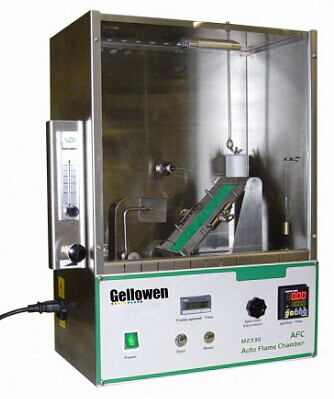
NewsInformation Center
The difference between 45° flammability tester and other flammability tester
2023/09/19
The 45° Flammability Tester is a testing device used to evaluate the combustion performance of materials. It has some unique differences compared with other combustion performance testing instruments. In the following article, we will introduce you in detail the difference between the 45° Flammability Tester and other combustion performance testing instruments.
First, let us understand what are the basic principles and functions of 45° Flammability Tester?
The 45° Flammability Tester is a device used to measure the burning properties of materials under specific conditions. It simulates real fire conditions by placing a material sample at a specific angle and applying a combustion source. During the test, the equipment records combustion time, combustion rate, combustion products and other parameters to evaluate the combustion performance of the material.
Compared with other combustion performance testing instruments, the 45° Flammability Tester has the following significant differences:
1. Test angle:
The 45° Flammability Tester is unique in its testing angle. Compared with the vertical or horizontal testing angles commonly used by other testing instruments, the 45° Flammability Tester places the material sample at a 45° angle for testing. This angle is closer to the actual application of materials in real fires and can more accurately evaluate the combustion performance of materials in actual use.
2. Combustion source:
45° Flammability Tester usually uses an open flame or a specific combustion source to simulate the combustion situation in a real fire. Other combustion performance testing instruments may use different combustion sources, such as electric heating wires, flame guns, etc. Different combustion sources will have different effects on the combustion performance of materials, so selecting suitable testing instruments and combustion sources is crucial to accurately evaluate the combustion performance of materials.
3. Test parameters:
The 45° Flammability Tester can measure multiple combustion performance parameters, such as combustion time, combustion rate, combustion products, etc. These parameters can provide detailed information about the material's combustion process and help users better understand the material's combustion performance. Other combustion performance test instruments may only provide partial or different test parameters, so the selection of test instruments needs to be evaluated based on specific needs.
4. Application scope:
45° Flammability Tester is widely used in various industries, such as building materials, textiles, electronic products, etc. It can evaluate the combustion performance of different types of materials and help users choose materials that are safer and more in line with requirements. Other combustion performance test instruments may be more focused on a specific area or type of material, so specific application needs need to be considered when selecting a test instrument.
To sum up, the difference between the 45° flammability tester and other combustion performance testing instruments is mainly reflected in the angle and standard of the test. It is mainly used to evaluate the combustion performance of materials in fire and other situations. It tilts the material at a 45° angle and conducts a combustion test under a specific heat source to understand the burning performance of the material under tilt.
Other combustion performance testing instruments may use different testing angles and methods. For example, the vertical combustion test instrument places the material vertically and applies a heat source to evaluate the combustion performance of the material in the vertical state. Other testing instruments may also use different standards and parameters to evaluate combustion performance, such as burning rate, smoke generation performance, flame spread, etc.
In summary, different combustion performance testing instruments differ in terms of testing angles, testing methods and evaluation criteria, depending on the specific combustion performance parameters and application fields that need to be evaluated.
Previous: Summary of flame retardant performance testing methods and standards
N e x t : How does a bacterial filtration efficiency tester work?





